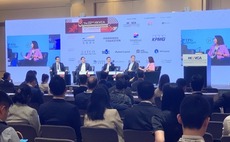
Secondaries: Back in the game
After several years of uncertainty, secondaries investments have returned to growth again, particularly in Asia. Strong pricing and healthy deal flow on the primary side could help maintain this upward trajectory
In future histories of the global private equity secondaries market, 2017 may well be seen as a turning point: the year that the asset class came into its own as an investment destination thanks to previously unseen levels of deal flow.
"I think pretty much everyone in the market agrees it will be a record year in terms of deal volume," says Matt Jones, a partner and co-head of global private equity secondaries at Pantheon. "The first half of the year got off to a far stronger start than certainly any years that I've worked in secondaries, and I've been in secondaries for 16 years. And the second half has had the normal strong deal flow that you normally see at that time of year."
Other participants echo Jones' sentiments, describing a market that seems to have rebounded from the uncertainty seen as having prevented growth in deal flow in recent years. Thanks to investor confidence and a strong fundraising environment, observers expect volumes to continue to grow – particularly in Asia, where investors are increasingly catching up to their counterparts in western markets.
While figures for the full year are not available yet, results for the first half showed a significant turnaround from previous years. Greenhill Cogent put the global deal volume at $22 billion for the first six months of 2017, more than the same period for any previous year including 2014, which currently holds the full-year record. The figure marks a return to growth following declines in first-half investment volume in 2015 and 2016.
Setter Capital estimates the first-half volume even higher, putting it $24.3 billion, up 59% year-on-year. For secondaries across all alternatives strategies, the total was $29.1 billion.
Stability counts
Industry participants generally agree on the factors behind the increase in investor appetite over the last year. One of the most commonly cited explanations is the improvement in market conditions, with the conclusion of high-profile political campaigns in various regions and a corresponding return to stability for their financial markets.
"What we saw last year was a tremendous amount of geopolitical uncertainty and a lot of equity market volatility that hampered the ability of both sellers and buyers to anchor pricing to a certain net asset value (NAV)," says Geoffrey Bevans, an analyst at Setter Capital, citing the US presidential election and the UK's Brexit referendum as sources of instability. "This year there's been significantly less of that and we have seen a real rebound in secondary market activity."
In addition, a lot of new secondaries funds have closed in 2017, after several years of dominance by 2006-2007 vintage vehicles. With these funds, raised in a period of overexposure to private equity and hit hard by the global financial crisis, having been mostly worked out, investors see the newer vintages as providing better value and greater potential for upside.
This perceived growth in opportunities has contributed to a build-up in investor interest, which has in turn put pressure on pricing. Greenhill indicated that as with deal volume, asset pricing across all secondaries investment strategies rose to 92% of NAV in the first half of 2017 after declining in each of the previous two years.
The fact that deal flow has still risen in a strong pricing environment is cited as an indicator of the appeal of secondaries investment strategies. Strong fundraising, combined with pricing, can help to create a very attractive environment for sellers as well, both on the GP side and the LP side. Investors that might not otherwise consider exiting via the secondary market may see these buyers as attractive partners due to their eagerness to deploy large pools of capital at rich valuations.
"What we've seen recently is that the particularly strong pricing has been able to move investors off of some of the non-core investments where they plan not to re-up with the manager," says Setter's Bevans. "Much of the reason for that is the amount of money that the secondary funds have raised, with fund-of-funds taking a strong interest as well."
Industry participants point to several transactions from 2017 as examples of this type of deal. Among the most notable was the $1.2 billion purchase of a customized portfolio comprising a portion of every Asian investment in Warburg Pincus' 11th global fund. Lexington Partners and Goldman Sachs' asset management arm led the transaction.
Out of Asia
The Warburg Pincus sale is also significant for what it suggests about the increasing acceptance of secondaries investing in Asia. While the deal featured global investors rather than Asia-specific firms, the participation of such prominent names in a deal for Asian assets could give local GPs confidence that secondaries are a viable investment strategy.
Setter's report indicates that this process could be underway. While Asian share of the global secondaries market remained largely unchanged, investment volume more than tripled, from $922 million to $3 billion. Observers believe this growth indicates that firms in this area are overcoming their previous perception of the asset class as castoffs from other managers.
"If you look at the primary market as a whole, the Asian portion is about 15-17%," says Lucian Wu, a managing director at HQ Capital. "So, from a macro perspective one would expect the secondary market to catch up, because there's a natural correlation between the primary and secondary markets."
Overall, investors see appetite for secondary investments as back on track after years of uncertainty, and absent any major economic shocks observers, they expect the growth to continue into 2018. Asian investors in particular anticipate strong deal flow even as the pressure on pricing continues.
"The key short-term challenge over the next 12 months is that pricing will continue to be very rich, just given the amount of dry powder available," says Martin Liew, head of integrated investments Asia at Partners Group. "The key opportunities will continue to be fund restructuring. We've already seen multiple GPs, particularly in Asia, that have been very open and happy to lead these., and we'll continue to see that given the need to generate liquidity for LPs."
Latest News
Asian GPs slow implementation of ESG policies - survey
Asia-based private equity firms are assigning more dedicated resources to environment, social, and governance (ESG) programmes, but policy changes have slowed in the past 12 months, in part due to concerns raised internally and by LPs, according to a...
Singapore fintech start-up LXA gets $10m seed round
New Enterprise Associates (NEA) has led a USD 10m seed round for Singapore’s LXA, a financial technology start-up launched by a former Asia senior executive at The Blackstone Group.
India's InCred announces $60m round, claims unicorn status
Indian non-bank lender InCred Financial Services said it has received INR 5bn (USD 60m) at a valuation of at least USD 1bn from unnamed investors including “a global private equity fund.”
Insight leads $50m round for Australia's Roller
Insight Partners has led a USD 50m round for Australia’s Roller, a venue management software provider specializing in family fun parks.







